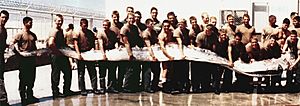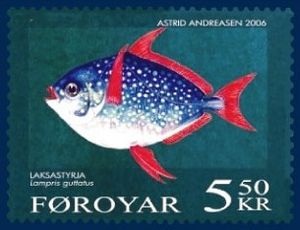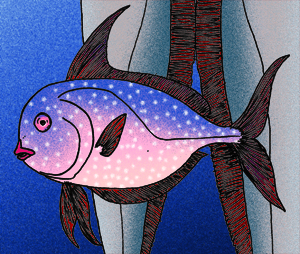Lampriformes facts for kids
Quick facts for kids Lampriformes |
|
|---|---|
 |
|
| Crested oarfish, Lophotus lacepede (Lophotidae) | |
| Scientific classification |
|
| Kingdom: | Animalia |
| Phylum: | Chordata |
| Class: | Actinopterygii |
| Order: | Lampriformes Regan, 1909 |
| Diversity | |
| 7 living families | |
| Synonyms | |
|
Allotriognathi |
|
Lampriformes is a group of ray-finned fish. These fish are also known as lamprids or lampriforms. They include amazing open-ocean and deep-sea fish like crestfishes, oarfish, opahs, and ribbonfishes.
Another name for this group is Allotriognathi. There are seven living families of lampriforms. Even though there are only about 20 different species in 12 genera, they are all quite unique.
The scientific name "Lampriformes" means "shaped like the bright one." This comes from lampris, which is the name for the opah. Opahs are round and bright. But most other lampriforms are long and thin, like ribbons! Even so, they are all connected by their special anatomy. Early fossils of these fish suggest that the first lampriforms looked more like the round opahs. The name comes from the Ancient Greek word lamprós (meaning "bright") and the Latin word forma (meaning "shape"). This refers to the opah's shiny colors.
Contents
Amazing Ocean Fish
These fish live in the open ocean. They swim far above the sea floor, usually in waters 100 to 1000 meters deep. As adults, they often have bright colors, with shiny crimson fins.
Lampriforms have many different body shapes. But they are usually flat from side to side. Some are round, while others are very long. The round ones are called bathysomes, meaning "deep-bodies." The long, ribbon-like ones are called taeniosomes, meaning "ribbon-bodies."
They also come in many sizes. Some are less than 30 cm long, like the sailfin moonfishes. But the giant oarfish can grow up to 17 meters long! This makes it the longest bony fish alive.
Lampriforms have 84 to 96 vertebrae (backbones). Their jaws can stick out really far. Their pelvic fins are usually near the front of their body, but some fish don't have them at all. Their dorsal fin is long and runs along most of their body. They do not have any fin spines. Some have a gas bladder to help them float, while others do not. They either have tiny scales or smooth skin.
Family Tree and History
Scientists study how lampriforms are related to other fish. They seem similar to some advanced spiny-rayed fish, but they are actually more basic. Many scientists believe they are a very old group within the advanced Teleostei fish. However, unlike their relatives, they don't have fin spines.
Scientists use DNA information to understand their relationships. This data suggests that lampriforms are close to other advanced teleost fish. But their exact family tree is still being studied.
Lampriforms first appeared a long time ago, around 80 million years ago. The oldest known lampriforms, Nardovelifer, lived in the late Campanian epoch. The first lampriforms had a round, "opah-shaped" body. The ribbon-like body shape developed later.
Most of the different lampriform groups appeared during the Paleocene period. One family, the Turkmenidae, looked like opahs and lived during this time. But they died out about 23 million years ago. Other ancient lampriforms include Bajaichthys, Palaeocentrotus, and Veronavelifer.
Types of Lampriforms

Sometimes, this group is split into two main types: the Bathysomi (round-bodied) and the Taeniosomi (ribbon-bodied). The Bathysomi group includes all lampriforms, while the Taeniosomi are a specific subgroup.
Here are the main families of lampriforms, including some ancient ones:
- Genus Bathysoma (fossil)
- Genus Nardovelifer (fossil)
- Genus Palaeocentrotus (fossil)
- Family Turkmenidae (fossil)
- Family Veliferidae — sailfin moonfishes (two genera, six species)
- Family Lampridae — opahs (one genus, two species)
Suborder Taeniosomi (ribbon-bodied fish)
- Family Lophotidae — crestfishes (two genera, three species)
- Family Radiicephalidae — tapertail (only one species)
- Family Trachipteridae — ribbonfishes (three genera, 10 species)
- Family Regalecidae — oarfishes (two genera, four species)
Timeline of Genera

See also
 In Spanish: Lampridiformes para niños
In Spanish: Lampridiformes para niños




